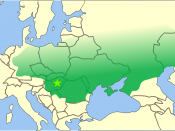Management versus Leadership, � PAGE �5�
Attila the Hun is remembered throughout history as a barbaric, ruthless warlord in the first century. King of the Huns, Attila amassed an efficient, unstoppable army reported to have numbered over 700,000 warriors. While Attila has been credited with his aggressive and fearless desire to conquer the known world, he has not been fairly acknowledged as a strategic, passionate leader. Attila exhibited the characteristics and principles that separate great leaders from among the rest. (Roberts, 1985).
In today's society, great leaders emerge from the rank and file of the corporate army. These leaders sometimes shine as visionary managers with a singular passion to excel and lead companies by executing aggressive plans tied to lofty mission statements. Just as often, individuals are elevated to management status without the leadership traits necessary to effectively guide and direct an organization and its members.
The question begs an answer⦠What are the roles and responsibilities that a leader and a good manager share in common? What are the differences? While there is no set laundry list of leadership traits, there are a number of characteristics and behaviors that define a true leader.
Among these traits are vision, desire, self-confidence, responsibility and dependability, and the ability to motivate others. (Roberts, 1985).
What defines a leader is his ability to strategically plan and execute his vision. Attila had a plan to conquer the Romans and rule the world. Bill Gates, chairman of Microsoft, had a mission to create the largest software company in the world. Both had a vision and executed their plans over the course of years, learning the secrets of their competition and continually making improvement to succeed. Additionally, a leader or a manager needs to anticipate change. The world does not stay the same, and neither...


![Roman villa in Gaul sacked by the hordes of Attila the Hun. Illustration from a book:Georges Rochegrosse, sa vie, son oeuvre J. Valmy-Baysse Nombreuses reproductions ([1910])](https://s.writework.com/uploads/1/18952/roman-villa-gaul-sacked-hordes-attila-hun-illustration-book-thumb.jpg)